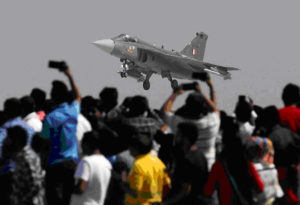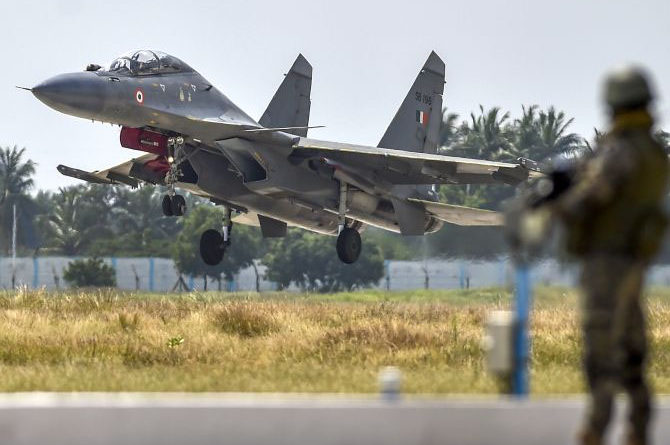General Rawat Hints At A Major Change In India’s Defence Thinking
14 May, 2020
‘It is crucial today to realise where we have reached in this 15 year-period in order to fully and properly assess the profundity of what General Rawat has said,’ points out Ambassador M K Bhadrakumar.
Through the past three years and more at the pinnacle of the Indian armed forces, General Bipin Rawat acquired a reputation as an outspoken general causing firestorms of controversy every now and then.
The controversies erupted largely due to his panache for making politically loaded remarks.
An impression accrued over time that General Rawat violated the purported core principles of nonpartisanship.
Indeed, he has been viciously pilloried for this reason.
However, General Rawat’s exclusive interview with The Times of India (external link) last weekend falls in an entirely different category, where he addresses the chorus of angry pro-forever-war generals (and ex-faujis) in our country who are disillusioned with the Modi government’s lack of enthusiasm to increase the defence budget.
The thrust of what General Rawat said in the interview can be summarised in three clusters:
- The coronavirus pandemic focuses attention on the social sectors and the overall state of the country’s economy where a reset of development strategies has become necessary demanding judicious resource allocation.
The country simply cannot afford the armament programme as of today, which is heavily dependent on import of prohibitively expensive arms purchases.
- The operational requirements of the armed forces should not be exaggerated.
India’s defence strategy is strictly limited to defending the country’s borders and dominating the Indian Ocean Region.
A realistic and thorough reappraisal of operational priorities is needed to reduce arms imports so as to optimally utilise the available budget.
- Equally, there is imperative need to indigenise the weapon systems. But ‘unrealistic GSQRs’ (general staff qualitative requirements) stand in the way.
Again, GSQRs should be redefined strictly in terms of our own operational requirements rather than by way of imitating the inventories of the US or other advanced countries.
General Rawat has spoken with remarkable candour. It has a stunning effect already. Especially, since a reasonable assumption is that General Rawat has articulated official thinking with a purpose to calibrate India’s defence strategy.
Indeed, what we see here is not a mere ‘tweaking’ of the defence strategy.
His views reflect radically new thinking. Concepts such as ‘cold start’, fighting two-front wars, interoperability and so on that were inherited from the UPA government (2004-2014) are being discarded.
The new emphasis is on local products and local supply chains — self-reliance.
General Rawat’s interview appeared two days before Prime Minister Narendra Damodardas Modi’s address to the nation on Tuesday where he said, inter alia, ‘Making India self-reliant is the only way to make the 21st century belong to India… This era of self-reliance will be our new pledge, we have to move on with new resolve.’
Suffice to say, this week becomes a truly defining moment if one were not to miss the wood for the trees.
The doctrine laid down by the PM and applied to the sphere of defence strategy by General Rawat punctuates a 15-year steady upward curve in the thinking and actions by our bureaucratic and military establishment since the signing of the landmark India-US defence agreement in 2005 by then defence minister Pranab Mukherjee and his American counterpart Donald Rumsfeld.
It is crucial today to realise where we have reached in this 15 year-period in order to fully and properly assess the profundity of what General Rawat has said in his weekend interview.
From the Indian perspective, what began as a much-needed modernisation of our armed forces, metastasized incrementally — almost inexorably — over this period as an obsessive drive to attain interoperability between the Indian and US militaries.
The American side has done extraordinarily well in dominating the Indian bureaucracy — civilian and military alike — to take us to this point today, where we no longer, as General Rawat plaintively framed it, tend to define our GSQRs not ‘as per our own operational requirements”, but instead in terms of “what the US or other advanced countries have’.
If the US has seven aircraft carriers, shouldn’t we at least have three? Our mind no longer applies logically, rationally.
The thinking is done for us largely by the Americans.

The Indian Air Force’s Light Combat Aircraft Tejas approaches to land at the Hindon air force station on the outskirts of New Delhi.
It is plain to see that, to quote General Rawat, ‘Anything on the surface can be picked up by satellites and knocked off by missiles. I think the Navy needs more submarines rather than aircraft carriers, which themselves require their own individual armadas for protection.’
Look at where we started this journey under the UPA rule and where we have reached today in such slavery of the mind.
The Americans did a brilliant job in calibrating the Indian mind to suit their purposes.
They have tickled our vanities by giving us promises to make us rulers of the global commons — and in future even the space, including outer space — and to take us to wherever the Chinese went.
Thus, the Americans have designated India as a Major Defence Partner (MDP). Incredible, isn’t it? They have never designated another country like this — not even their closest Anglo-Saxon, NATO ally — Britain.
We became ecstatic when we were told that their ‘MDP designation is unique to India’. We lost our mental poise in that ecstacy.
The Indian and American think tankers promptly sat down to jointly outline ‘actionable recommendations’ (external link) for the Indian policymakers’s consideration with a view to make the MDP designation optimal in its application.
We refused to see the writing on the wall — that MDP is quintessentially a sound business strategy to promote the commercial interests of American arms vendors.
The US has applied much the same technique to make its NATO allies a captive market for American arms exports.
If they created the NATO doctrine in the Cold War era casting the former Soviet Union as their eternal ‘enemy’, today it is about the two revisionist powers — Russia and China.
So they keep whispering into our ears that in China, India has an eternal enemy.
For tackling the Soviet Russian enemy, the US and its NATO partners had enshrined interoperability of the armed forces of the Western alliance as the cardinal principle of the common defence strategy of the member countries.
The result is plain to see.
The US supplies the bulk of the NATO countries’s requirements of weaponry. Not only that, the US will not countenance if a member country chooses to turn to a third country for meeting its boutique requirements even in a specific situation.
Washington threatens to sanction such errant partners — as it is today doing to Turkey, which, by the way, has the second biggest army amongst the NATO allies, next only to the US, and has specific defence needs, given its geography and the post-cold war geopolitical situation in its surrounding regions.
The Indian bureaucratic establishment — civilian and military — should have no illusions that Turkey’s plight today can well be India’s tomorrow, if push comes to shove, and New Delhi ever decides to exercise its strategic autonomy in the pursuit of its national interests that does not conform to the US’ regional and global strategies.
In fact, the Americans are in such punishing mood that they are today training, arming and financing the Kurdish separatist-terrorist groups that work toward vivisecting Turkey — the equivalent of the Hizb-ul-Mujahideen and Lashkar-e-Tayyiba combined in today’s circumstances in J&K.
To cut a complex story short, on the one hand, brilliant minds like Ashton Carter — an Oxford-trained physicist whose entire adulthood was spent in the bowels of the US defence and intelligence — sold to us the doctrine of interoperability which has become the mantra today of the Indian defence establishment.
Carter could do it with such delectable ease since we didn’t even have an interlocutor to match his intellect or vast experience — whose career graph since 1993 was almost entirely devoted to strategic affairs.
By the way, for his unparalleled service to the US national security, Carter was on five occasions awarded the Pentagon’s Distinguished Public Service Medal. Besides, he is also the recipient of the CJCS Joint Distinguished Civilian Service Award and the Defense Intelligence Medal for his contributions to intelligence.
It is doubtful if India can produce someone of his calibre in the next quarter century.
Now, why did the US press him into service on India? Why should the deepening and expansion of the interoperability between the two militaries be such top priority? Why such unseemly hurry?
All that only goes to underscore the criticality of locking in India as a defence partner to meet the emergent requirements of the US’s ‘Indo-Pacific’ strategies to contain China, the rising rival on the horizon who threatens to challenge America’s century-long global hegemony.
The slavery of the Indian mind is such today that, if General Rawat is to believed, the Indian military is ‘misrepresenting our operational requirements’ to the political masters to hoodwink them into permitting the acquisition of fanciful weaponry from abroad that are by no stretch of imagination relevant to the country’s actual defence requirements.
The shameful tragedy is that the Americans have bought us cheap.
Suffice to say, there is hardly anyone among India’s elite today who doesn’t have a son or daughter or son-in-law or nephew settled in the US.
Green Card has become the magical wand of the US that can open any door in Delhi today.
To my mind, therefore, the real significance of PM’s address to the nation last night lies not in the combat against a medieval virus but in his determination to turn the present crisis into a window of opportunity to liberate the Indian mind and to choreograph and launch an entirely new approach for India’s national strategy pivoted on principles of self-reliance.
Having said that, when it comes to the defence arena, prudence demands that one must keep fingers crossed.
To be sure, there will be institutionalised opposition from the Indian civilian and military bureaucracy and other entrenched interest groups who can be trusted to wage a war of attrition on the political leadership.
If ‘Make in India’ is languishing and the road to develop an indigenous defence industry for the country — something that a much smaller country like Iran could achieve with such stunning success despite very heavy odds — remains deserted without much traffic to speak of, the principal reason for it is that PM has to juggle a dozen balls in the air simultaneously at any given time.
Succinctly put, notwithstanding his fame for possessing a forceful will, attention span remains limited, whereas follow-up is always the all-important quotient of statecraft in the Byzantine corridors of power.
This is where, in retrospect, General Bipin Rawat’s appointment as India’s first Chief of Defence Staff assumes an altogether new meaning.
Courtesy: rediff.com

